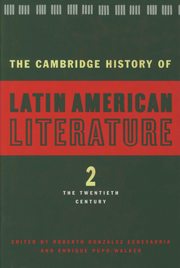Book contents
- Frontmatter
- Introduction to Volume 2
- 1 Modernist poetry
- 2 Modernist prose
- 3 The Vanguardia and its implications
- 4 The literature of Indigenismo
- 5 Afro-Hispanic American literature
- 6 The Criollista novel
- 7 The novel of the Mexican Revolution
- 8 The Spanish American novel from 1950 to 1975
- 9 The Spanish American novel: recent developments, 1975 to 1990
- 10 Spanish American poetry from 1922 to 1975
- 11 The modern essay in Spanish America
- 12 Literary criticism in Spanish America
- 13 The autobiographical narrative
- 14 The twentieth-century short story in Spanish America
- 15 Spanish American theatre in the twentieth century
- 16 Latin American (Hispanic Caribbean) literature written in the United States
- 17 Chicano literature
- Index
- Bibliographies
- References
15 - Spanish American theatre in the twentieth century
Published online by Cambridge University Press: 28 March 2008
- Frontmatter
- Introduction to Volume 2
- 1 Modernist poetry
- 2 Modernist prose
- 3 The Vanguardia and its implications
- 4 The literature of Indigenismo
- 5 Afro-Hispanic American literature
- 6 The Criollista novel
- 7 The novel of the Mexican Revolution
- 8 The Spanish American novel from 1950 to 1975
- 9 The Spanish American novel: recent developments, 1975 to 1990
- 10 Spanish American poetry from 1922 to 1975
- 11 The modern essay in Spanish America
- 12 Literary criticism in Spanish America
- 13 The autobiographical narrative
- 14 The twentieth-century short story in Spanish America
- 15 Spanish American theatre in the twentieth century
- 16 Latin American (Hispanic Caribbean) literature written in the United States
- 17 Chicano literature
- Index
- Bibliographies
- References
Summary
Until well into the twentieth century most stages in Spanish America were characterized by plays in which peninsular theatre exerted a dominating influence. It was not until the 1920s that theatre groups in a number of Spanish American countries broke definitively with the aesthetic hold of the nineteenth century and its emphasis on costumbristic realism and comedy of manners in order to enter a new phase that incorporated experimentation with expansion and diversification of themes and techniques. Prior to the emergence of these experimental theatre groups in Mexico, Argentina, and Puerto Rico, the theatre had been dominated artistically and economically by companies composed largely of Spaniards. Typically, the stage was filled with actors mouthing platitudes in a peninsular accent, dressed in old-fashioned costumes surrounded by dated scenery in outmoded theatrical halls. The audiences before which these commercial companies performed were generally bourgeois and upper-class, affiliated with the government, and not overly critical of official political policy. In order to excise a false, out-dated tradition whose social realism and fixed sense of “dramatic illusion” no longer matched the reality beyond the theatre, experimental groups in several countries were formed to create a new dramatic tradition that would address psychological and metaphysical concerns in an innovative dramatic idiom based on technical advances.
Individual differences related to sociocultural conditions make generalizations difficult among the countries in Spanish America, and the number of countries prohibits even a cursory reference to activities in each area. A brief review of the experiences in three major theatrical regions will serve as a representative summary of the nature of the transition from the illusionistic, costumbristic, commercial theatre of the nineteenth century to the formation of a mature dramatic expression that gives testimony to the multiplicity of national identities that comprise each of the nations of Spanish America.
- Type
- Chapter
- Information
- The Cambridge History of Latin American Literature , pp. 497 - 525Publisher: Cambridge University PressPrint publication year: 1996



